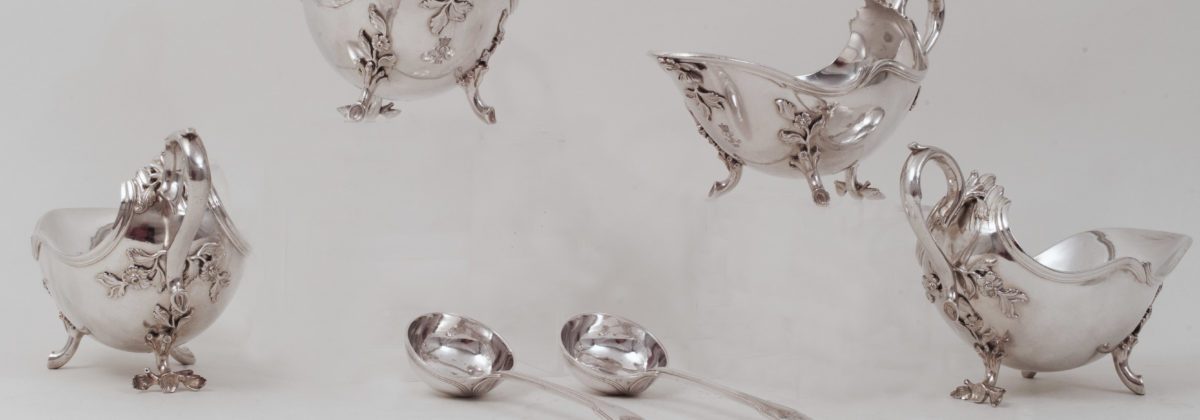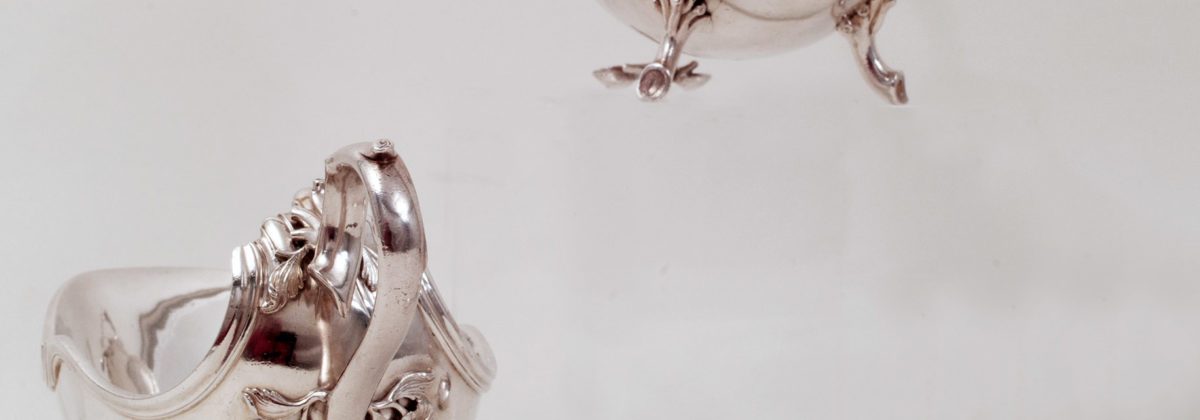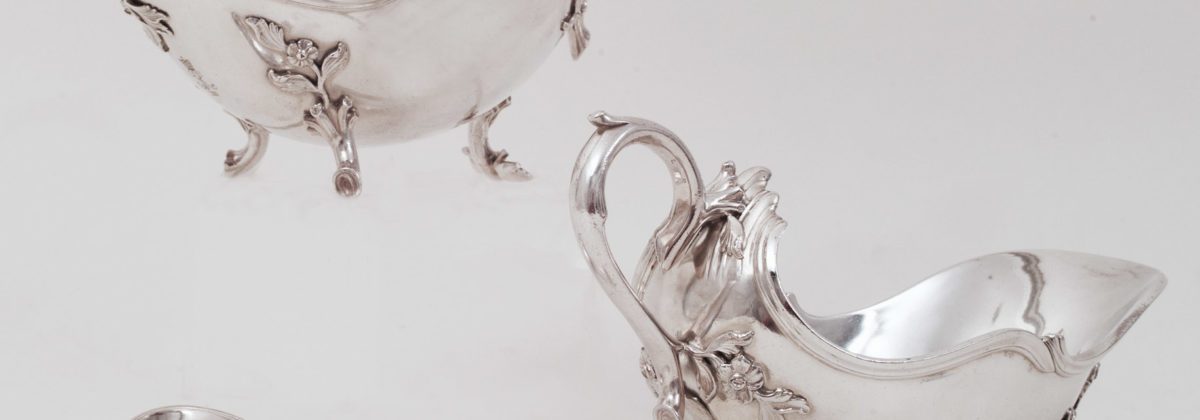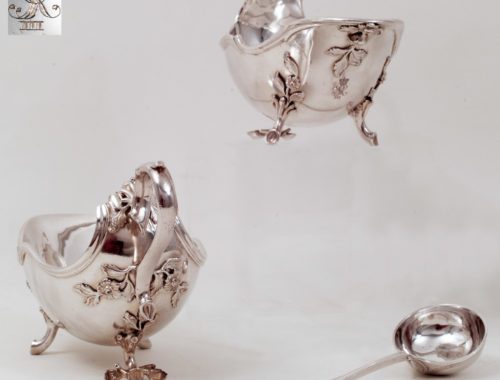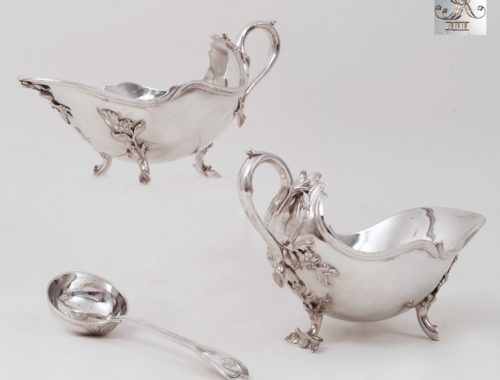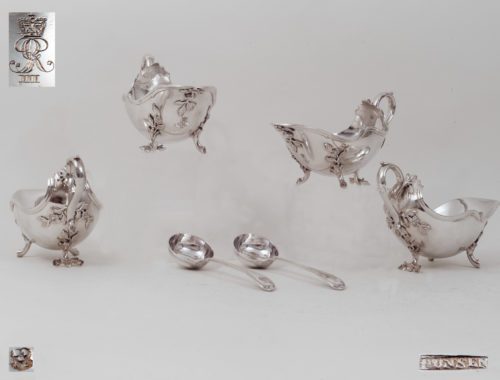Objectnumber # 809
Hanover, one pair 1766 and one 1779
Franz Peter Bunsen (ca. 1725-1795)
City’s mark: a cloverleaf with the number “15” underneath for Hanover (s. Scheffler, Nr. 1385)
Maker’s mark: “BUNSEN” in a rectangle for Frantz Peter Bunsen (s. Scheffler, no. 1384)
Date letters: D [for 1766; s. Scheffler p. 714 and no. 1381] and E [s. Scheffler p. 714]
Engravings: Royal cypher, George III
Provenance: Property of the Royal House of Hanover
Length: 23,5 cm (9 1/4 in.); weight: 1470,5 gr. and 1471 gr.
Detailed Information
Two Pairs of Royal German Silver Sauceboats from the Hanover Service of George III with their Serving Ladle
These magnificent pairs of silver, rococo sauce-boats are royal commissioned. The sauce-boats have the form of a boat and very elegant, undulating rims. The body is raised on three cast feet, modelled like branches. These are realistically formed and on the spot where they are attached to the body of the sauce-boat, they have applied, cast flowers. The stern of the body is formed through an embossed shell and it is towards the upper part lively curved. An ear-shaped cast handle is applied on it. The bow serves also as a serving spout and is adorned with cast foliage. Underneath this, the cypher “GR/III” under crown for George III (1738-1820), King of Great Britain and Ireland, Elector and since 1814 King of Hanover. Both pairs are each accompanied by a silver Fiddle Thread pattern ladle. All pieces bear the engraved cypher of George III (engraving from 1841, cf. Seelig 2007, p. 159, fig. 22).
The Silver of the House of Guelf (Welf)
The House of Guelf had always had a lot of treasures made in silver. Part of the raw material for the making of them came from the Harz region in Germany. In July 1768, George III. approved the melting down of around 126 kilos silver (tableware). Pieces of the silver collection that were not anymore in fashion were chosen for this large action of destruction. Around one third of the collection was melted down, initially not with the intention to make new, fashionable pieces of silver, but to use the money made from the material for social purposes.
In 1770, there was however the intention to make a new silver service that would be made according to the fashionable style of the eighteenth century. For this new service, it has been decided to increase the number of sauceboats. Overall, it can be assumed that the service was initially planned for 60 to 72 persons, while it was decided it to produce it in 15-lots silver (i.e. 937,5/1000 silver, which would correspond to the English standard of 925/1000 silver).
Franz Peter Bunsen, goldsmith of the court, had been chosen with the approval of the monarch for the making of this new royal service. The duration for the making of the pieces was initially calculated at almost 4 years. From the survived documents, it appears that George III – who had never visited Hanover – was implicated in all the different phases of the making of the service. He put a lot of importance on the making of a “service à la française”, which was the latest kind of official dining in the eighteenth century.
For this reason, it has been after all decided to place the commission for such a service to a French maker. Robert Joseph Auguste (1723-c. 1805) delivered a great number of it, however Franz Peter Bunsen had been working on the service as well, to make additions of needed pieces. The whole service was ready in 1790, while during the next years, there have been some additions.
In 1841, the cypher of George III has been retrospectively added to this so called “A” service. This was the decision of the son of George III, Ernest Augustus (1771-1851), King of Hanover since 1837, who also lived in Hanover. 2.226 pieces of this service have been adorned with the cypher of George III by Johann Carl Matthias.
With the accession of the House of Hanover in 1714, British monarchs tended to use royal cyphers as a personal and royal symbol, rather than the royal badges, which were until then into use. Royal cyphers are practical the monogram of the monarch, accompanied by the crown. Royal badges alluded to a specific person, but they could be also borne by others who wanted to show a kind of livery badge. These were often flowers or other symbols (like e.g. stars).
Sauceboats were made since the Middle ages, however they shape has been set around the beginning of the eighteenth century. A major role in the influence of it as well as in the use of the sauceboat has had the French court of Versailles. Sauce-boats were often made in pairs or in two pairs to serve warm sauces.
Maker
Franz Peter Bunsen (Bundsen), born in Hanover in ca. 1725, was since 1770 a court gold- and silversmith. He became a master maker in 1754. Two spectacular objects of the Franz Peter Bunsen, two silver, royal kettle drums, made for the Hanoverian Life Guards of George III (1738-1820) are held in The Metropolitan Museum of Art. Further works from him are held in the Museum August Kestner and the Historisches Museum, both Hannover.
Literature
Seelig, Lorenz, ‘Das Silberservice König Georgs III. Von Robert-Joseph Auguste und Frantz Peter Bundsen. Zur Goldschmiedekunst des frühen Klassizismus in Paris, London und Hannover’, In: Münchner Jahrbuch der Bildenden Kunst, 3. Folge, Bd. LVIII, Munich: Staatliche Kunstsammlungen & Zentralinstitut für Kunstgeschichte, 2007, p. 141-207.
Scheffler, Scheffler, W., 1965, Goldschmiede Niedersachsens: Daten – Werke – Zeichen, 2. Halbband, Aerzen-Hamburg, Berlin: De Gruyter.
Waldemar R. Röhrbein: Bunsen, Peter Franz. In: Hannoversches Biographisches Lexikon. Schlütersche Verlagsgesellschaft, Hannover 2002, p. 79.


